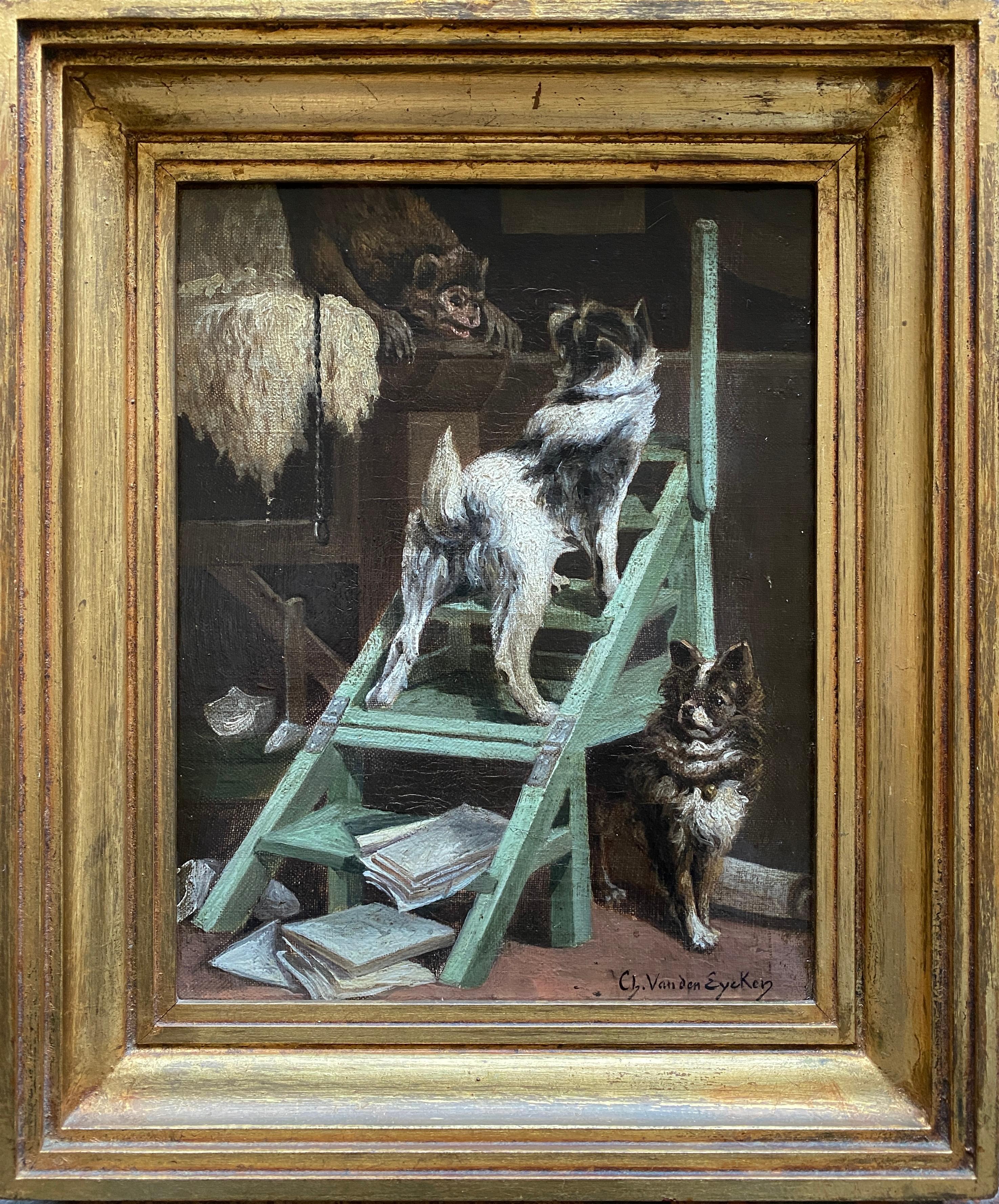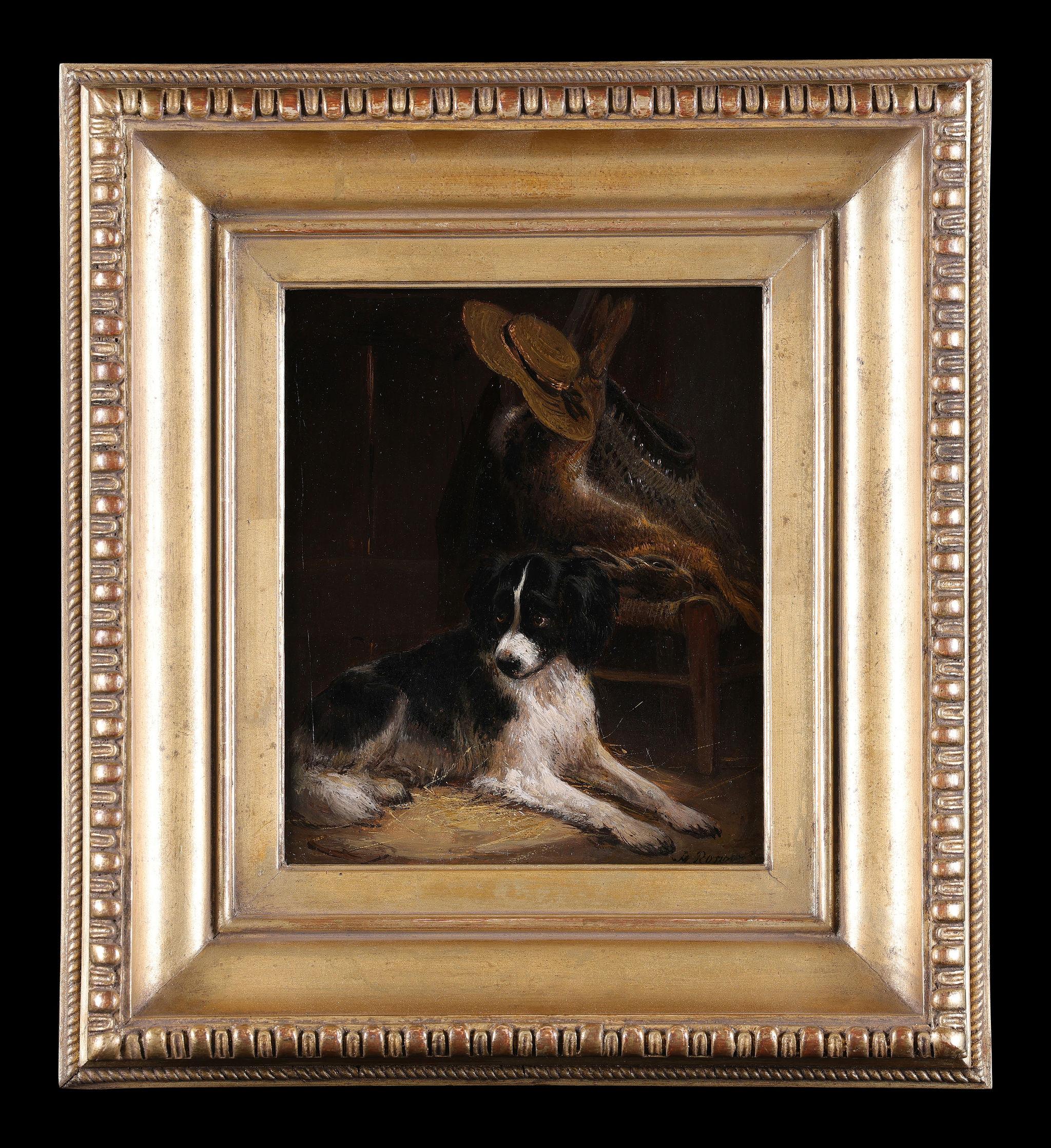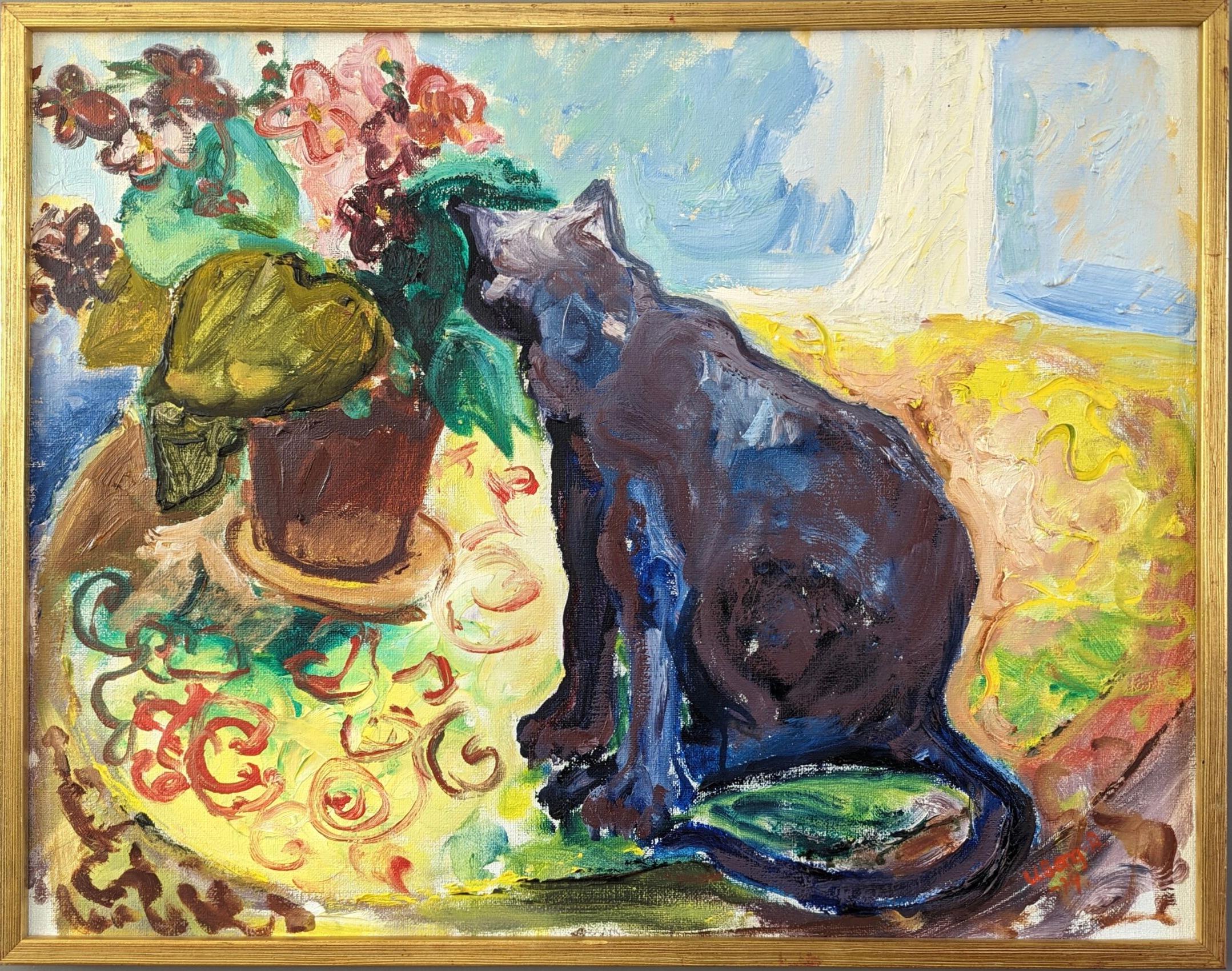Items Similar to ‘Cats Playing around a Mirror’ by Joseph Bail (1862 – 1921), French Painter
Video Loading
Want more images or videos?
Request additional images or videos from the seller
1 of 18
Joseph Bail‘Cats Playing around a Mirror’ by Joseph Bail (1862 – 1921), French PainterLate 19th century
Late 19th century
About the Item
Joseph Bail
Limonest 1862 – 1921 Paris
French Painter
‘Cats Playing around a Mirror’
Signature: signed lower right ‘Bail Joseph’
Medium: oil on canvas
Dimensions: image size 45,5 x 37,5 cm, frame size 69 x 61 cm
Provenance: from a private Duch collection
Notes: French naturalist painter known for his still lifes and depictions of kitchen scenes. Trained by his father and later under Jean-Léon Gérôme and Carolus-Duran, he gained recognition for works in 1887 and in 1894. He won the gold medal at the 1900 Universal Exposition. Influenced by Chardin and realists like Vollon, he focused on detail and color accuracy in his compositions until his death in 1921.
Biography: Joseph Bail, the youngest scion of the esteemed painter Jean Antoine Bail, emerged from the cradle of artistic heritage into the vibrant world of Lyon, where Romanticism swirled in the air and Realism took root in the canvas. Born in 1862, he was nurtured amidst the masterpieces of his father, who not only imparted to him the skills of the craft but also instilled in him a profound appreciation for the art that transcended mere brushstrokes.
Under the watchful guidance of his father and later in the academic embrace of luminaries like Jean Léon Gérôme and Charles-Emile Carolus-Duran, Joseph Bail's artistic journey began to unfold like an intricate tapestry, woven with threads of tradition and innovation. His debut at the Salon in 1878 heralded the advent of a talent poised to make a mark, although the details of this early exhibition remain shrouded in the mists of time.
The 1880s witnessed Bail's artistic prowess blossoming into full bloom, as his canvases bore witness to a kaleidoscope of subjects - from poignant portraits capturing the essence of familial bonds to lively genre scenes depicting the hustle and bustle of everyday life. Inspired by the likes of Chardin and steeped in the Realist tradition, Bail's brush danced with a familiarity that belied his youth.
It was his series of cooks, immortalized in various states of culinary labor and leisure, that would come to define Bail's oeuvre and draw parallels with the works of Théodule Ribot. Yet, beneath the surface of these seemingly mundane scenes lay a nuanced understanding of light and form, a testament to Bail's mastery of his craft.
The accolades bestowed upon him by the discerning eyes of the Third Republic spoke volumes of his talent - from the honorable mention in 1885 to the gold medal in 1900, each award was a testament to Bail's unwavering dedication to his art. Yet, amidst the glimmering medals and accolades, Bail remained steadfast in his commitment to the Realist aesthetic, eschewing the allure of trends in favor of a timeless expression of truth.
In 1902, the Salon bestowed upon him the rare honor of a medal of honor, a fitting tribute to a lifetime devoted to the pursuit of artistic excellence. Though the sands of time may have swept away the footprints of many artists, Joseph Bail's legacy endures as a beacon of inspiration, a testament to the enduring power of art to transcend the bounds of time and space.
- Creator:Joseph Bail (1862 - 1921, French)
- Creation Year:Late 19th century
- Dimensions:Height: 27.17 in (69 cm)Width: 24.02 in (61 cm)Depth: 2.37 in (6 cm)
- Medium:
- Movement & Style:
- Period:
- Condition:The artwork is elegantly presented within a magnificent golden (gold leaf) framing, specially created for the painting. This piece is showcased in a state suitable for immediate gallery hanging, impeccably preserved in its good condition.
- Gallery Location:Bruges, BE
- Reference Number:1stDibs: LU2006214369132
About the Seller
5.0
Vetted Seller
These experienced sellers undergo a comprehensive evaluation by our team of in-house experts.
Established in 1998
1stDibs seller since 2022
14 sales on 1stDibs
Typical response time: 1 to 2 days
- ShippingRetrieving quote...Ships From: Bruges, Belgium
- Return PolicyA return for this item may be initiated within 14 days of delivery.
More From This SellerView All
- Confrontation, Charles Van Den Eycken, Brussels 1859 – 1923, Belgian PainterBy Charles Van Den EyckenLocated in Bruges, BEConfrontation Van Den Eycken Charles Brussels 1859 – 1923 Belgian Painter Signature: Signed bottom right Medium: Oil on canvas Dimensions: Image size 28 x 21,50 cm, frame size 36 x 30 cm Biography: Van Den Eycken Charles (alias Charles Duchene) was born in Brussels in 1859. He was an animal painter, mainly dogs and cats and interiors. He was the son of Charles Van Den Eycken...Category
19th Century Romantic Animal Paintings
MaterialsCanvas, Oil
- ‘Meal Time for all’ by Hermann Werner (1816 – 1905), signed and dated 1870By Hermann WernerLocated in Bruges, BEHermann Werner Samswegen 1816 – 1905 Düsseldorf German Painter ‘Meal Time for all’ Signature: signed lower right and dated ‘H. Werner. 1870 ' Medium: oil on canvas Dimensions: ima...Category
Late 19th Century Romantic Interior Paintings
MaterialsCanvas, Oil
- “A Lady playing with a Cat” by Paul De Frick (1864 - Paris - 1935), dated 1896By Paul de FrickLocated in Bruges, BEPaul De Frick 1864 - Paris - 1935 French Painter “A Lady playing with a Cat” Signature: signed lower left and dated ‘P. de Frick. 96’ Medium: oil on canvas Dimensions: image size ...Category
Late 19th Century Impressionist Interior Paintings
MaterialsCanvas, Oil
- A Meal, Charles Van Den Eycken, Brussels 1859 – 1923, Belgian PainterLocated in Bruges, BEA Meal Van Den Eycken Charles Brussels 1859 – 1923 Belgian Painter Signature: Attributed to Charles Van Den Eycken Medium: Oil on panel Dimens...Category
19th Century Realist Animal Paintings
MaterialsOil, Wood Panel
- André Plumot, 1829 – 1906, Shepherds Couple with Herd in a River LandscapeLocated in Bruges, BEPlumot André Antwerp, Belgium 1829 – 1906 Belgian Painter Shepherds Couple with Herd in a River Landscape Signature: Signed bottom left and dated 1877 Medium: Oil on canvas Dimensi...Category
Late 19th Century Romantic Landscape Paintings
MaterialsOil, Canvas
- ‘Peasant Children walking the Donkeys’ by Edgar Bundy (1862 – 1922), dated 1885Located in Bruges, BEEdgar Bundy Brighton 1862 – 1922 London British Painter ‘Peasant Children walking the Donkeys’ Signature: signed lower right and dated ‘Edgar Bundy 1885' Medium: oil on canvas Dim...Category
Late 19th Century Romantic Animal Paintings
MaterialsCanvas, Oil
You May Also Like
- Waiting with the Day's RewardsBy Henriëtte Ronner-KnipLocated in St. Albans, GBSigned. Oil on Panel. Signature lower right. It is framed in the original antique gold leaf frame. HENRIETTE RONNER-KNIP Amsterdam 1821 - 1909 Brussels Henriette Ronner-Knip is ...Category
Mid-19th Century Romantic Animal Paintings
MaterialsOil
- Merry Goats: Juicy Pastoral. Oil painting with Goats . Farm animal artLocated in Zofingen, AGOn the canvas of this picturesque painting unfolds a marvelous spectacle - two cheerful goats immersed in the world of fresh nature. They chew on the succulent grass with ease and jo...Category
21st Century and Contemporary Post-Impressionist Animal Paintings
MaterialsCanvas, Cotton Canvas, Oil
- Global Warming rich color humor art topical subject birds and human interactionBy Stephen BassoLocated in Brooklyn, NYoil on stretched canvas signed an dated on reverse. Basso's highly original pastels and oil paintings are romantic yet thought provoking narratives. His whimsical works are alive wit...Category
2010s Neo-Expressionist Animal Paintings
MaterialsCanvas, Oil
- 1974 Vintage Mid-Century Interior Scene Cat Oil Painting - The Curious EncounterLocated in Bristol, GBTHE CURIOUS ENCOUNTER Size: 53.5 x 67 cm (including frame) Oil on Canvas A striking and lively composition, executed in oil onto canvas and dated 1974. The canvas bursts with energ...Category
Mid-20th Century Modern Interior Paintings
MaterialsCanvas, Oil
- "Nine Lives II" Oil on canvasBy Katherine FraserLocated in Philadelphia, PAThis piece titled "Nine Lives II" is an original artwork by Katherine Fraser and is made of oil on canvas. This piece measures approximately 23.5" x 27.5" a...Category
21st Century and Contemporary Contemporary Animal Paintings
MaterialsOil, Canvas
- "Interior of a Stable" William Hart, Hudson River School Antique, Boy and HorseBy William HartLocated in New York, NYWilliam M. Hart (1823 - 1894) Interior of a Stable Oil on canvas 17 x 12 inches Provenance William Macbeth Gallery, New York Mrs. Mabel Brady Garvan Collection Christie's New York, Sporting Art, November 28, 1995, Lot 116 Ann Carter Stonesifer, Maryland Estate of above Brunk Auctions, Asheville, North Carolina, January 27 2018, Lot 777 Exhibited New York, The Metropolitan Museum of Art, Life in America, April 24 - October 29, 1939, no. 123, illustrated. New York, Macbeth Gallery, 1892: Sixtieth Anniversary Exhibition, April 1952, p. 5, no. 18. Literature Turner Reuter Jr, Animal and Sporting Artists in America, Middleburg, Virginia, 2008, p. 306. Gary Stiles, William Hart: Catalogue Raisonné and Artistic Biography, no. 1126, illustrated. It should be noted that the Francis Patrick Garvan and Mrs. Mabel Brady Garvan collection, of which this painting was a part of, was one of the foremost American Art collections and now makes up a large part of the Smithsonian American Art Museum and the Yale University Art Gallery collections. Born in 1823 in Paisley, Scotland, William Hart emigrated with his parents to the United States at the age of nine and settled in Albany, New York. It was here that Hart first began his artistic training when he was placed under the tutelage of Messrs, Eaton & Gilbert, the prestigious coach-makers from Troy, New York. During this time, Hart learned how to decorate coach panels, covering them with either landscapes or figurative compositions. At the age of seventeen, he was eagerly contemplating an artist’s profession. Consequently, he left the mechanical trade of coach-making and began expanding his artistic pursuits to more refined endeavors. Hart followed coach-making with decorating window shades and later developed an interest in portraiture. Around 1840, he established his first formal studio in his father’s woodshed in Troy. There, he created many likenesses of individuals, affording him a nominal income. Once, he remarked that he felt prouder over his first fee of five dollars for painting a head then for the larger sums he would command later in his career. Nevertheless, his wages from portraits during this early period proved insufficient. Thus, he expanded into landscape painting, allowing him to barter his works or sell them for modest prices. In 1842, Hart moved to Michigan in an attempt to further his success; portraiture remained his primary means of support. Unfortunately, his experiences in the West were disappointing. Hart spent three years living a rough existence until he finally returned to Albany in 1845. Upon his return, he fully devoted himself to the art of landscape painting. Despite his failing health, he worked diligently to perfect his skill until 1849 when he traveled abroad to his native land of Scotland. This trip was made possible through the generosity of his patron and advisor, Dr. Ormsby of Albany. For three years, he studied in the open-air, creating brilliant sketches of the Scottish Highlands and the surrounding British Isles. Returning to Albany once more in 1852, Hart enjoyed improved health and was reinvigorated with purpose. The following year, he moved to New York and opened a studio, promoting himself as a specialist in landscape painting. Hart became a regular contributor to the National Academy of Design. His works received a great deal of attention from artists and connoisseurs alike, all of whom praised him for his fresh, self-taught style. In 1855, he was designated as an associate of the National Academy of Design; three years later he was elected to Academician. In 1865, he was unanimously chosen to be the first president of the Brooklyn Academy of Design. It was during his tenure there that he delivered his famous lecture The Field and Easel, which emphasized the distinguishing principles of landscape art in America. Hart argued that landscape painters should express the “look of the place” being depicted.Critics during the 1870s noted his sensitive balance between capturing a strict “real” interpretation of nature and that of a more “ideal” sentimental tone. For instance, in 1869, Putnam Magazine noted that Hart brought back “exquisite studies” of the surrounding Tappan...Category
19th Century Hudson River School Animal Paintings
MaterialsCanvas, Oil





